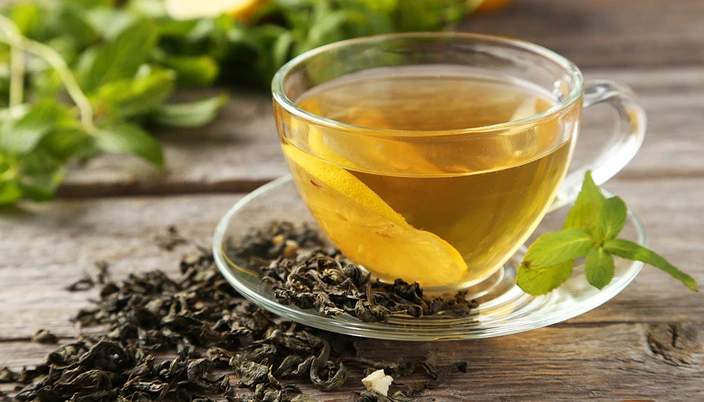Tea, a timeless elixir celebrated worldwide, emerges not only as a cultural cornerstone but also as a subject of scientific inquiry. Recent insights into major tea-producing nations, including the United States, United Kingdom, and China, reveal that black tea reigns supreme, constituting a remarkable 75 percent of global tea consumption. Beyond cultural preferences, the prevalence of green tea in Japan and China showcases the intricate tapestry of tea’s influence on diverse societies.
Derived from the leaves of the Camellia sinensis plant, tea undergoes a captivating metamorphosis post-harvest. The wilting and oxidation process, guided by enzymatic reactions, bestows upon tea leaves their characteristic dark hues and the enticing aroma synonymous with this ancient beverage. This oxidation journey can be arrested by applying heat, thus dictating the type of tea produced. Black tea, with its full-bodied richness, undergoes complete oxidation. In contrast, green tea preserves its unoxidized essence, and oolong tea strikes an elegant balance with partial oxidation. White tea, a delicate variant, draws from minimally oxidized young leaves or buds.
The spectrum of tea extends beyond traditional brewed leaves to encompass instant mixes and ready-to-drink iced teas. A crucial distinction lies in the realm of herbal teas, which, despite common nomenclature, are not true teas but rather infusions of dried fruits, herbs, and flowers.
At the heart of tea’s allure lies its intricate composition, encompassing polyphenols, alkaloids (caffeine, theophylline, and theobromine), amino acids, carbohydrates, proteins, chlorophyll, volatile organic compounds, fluoride, aluminum, minerals, and trace elements. Polyphenols, particularly catechins, emerge as the stars responsible for the health benefits traditionally attributed to tea, with epigallocatechin-3-gallate (EGCG) reigning supreme in green tea.
Catechin Concentrations in Green Tea Infusions:
- EGCG: 117–442 mg/L, 25–106 mg/8 fl oz
- Epigallocatechin (EGC): 203–471 mg/L, 49–113 mg/8 fl oz
- Epicatechin-3-gallate (ECG): 17–150 mg/L, 4–36 mg/8 fl oz
- Epicatechin (EC): 25–81 mg/L, 6–19 mg/8 fl oz
Black tea, though lower in catechins, boasts elevated concentrations of thearubigins and theaflavins due to prolonged oxidation. Oolong and white teas offer unique flavor profiles, while the polyphenol content of ready-to-drink teas may vary based on tea type, amount, brew time, and temperature.
Tea’s Potential Role in Cancer Prevention: Deciphering the Science
The predominant polyphenols in green tea, notably EGCG, unveil potent antioxidant properties. These compounds, adept at scavenging free radicals, hold promise in shielding cells from DNA damage caused by reactive oxygen species. Beyond their antioxidant prowess, tea polyphenols reveal anti-tumor potential in laboratory and animal studies. They demonstrate the ability to inhibit tumor cell proliferation, induce apoptosis, and potentially impede angiogenesis and tumor cell invasiveness.
Moreover, tea polyphenols may serve as guardians against UVB radiation damage and modulate immune system function. Green tea, in particular, activates detoxification enzymes, contributing to protection against tumor development. Despite these compelling findings, the intricate mechanism linking tea to cancer prevention remains elusive.
Safety Considerations and Tea Varieties: A Balancing Act
Tea, recognized as safe by the U.S. Food and Drug Administration, carries minimal safety concerns. Studies, however, underscore potential adverse effects associated with high-dose green tea extract consumption, including gastrointestinal discomfort and nausea.
Caffeine, inherent in tea, poses potential adverse effects, yet moderate consumption (about 300 to 400 mg per day) entails minimal health risks. The caffeine content varies across tea types, with black teas containing higher levels than green or white teas.
The presence of aluminum in tea plants raises questions, but evidence of aluminum toxicity linked to tea consumption is lacking. Tea’s interaction with iron absorption is noteworthy, potentially impacting individuals with iron-deficiency anemia.
Human Studies on Tea and Cancer Prevention: A Mosaic of Findings
While tea’s health benefits have been extolled for centuries, human studies, both epidemiologic and clinical, present an intricate mosaic of findings. Epidemiologic studies, exploring tea’s association with cancer risk, yield inconsistent results due to variables such as tea preparation, type, and lifestyle factors.
Clinical trials investigating tea’s impact on cancer incidence or mortality are limited. Green tea extracts have shown promise in reducing oral lesion progression and oxidative DNA damage. However, the translation of this evidence into a concrete understanding of cancer risk remains a complex puzzle.
Ongoing Research: Navigating Uncharted Territory
The quest to unravel the mysteries of tea’s potential health benefits continues through ongoing research. Epidemiologic studies, exploring diverse populations and refining methodologies, aim to reconcile conflicting findings. Clinical trials, while limited, offer glimpses into tea’s impact on specific conditions, such as oral lesions and oxidative DNA damage. As the scientific community delves deeper, the nuanced nature of tea’s influence on cancer prevention demands thorough exploration.
The National Cancer Institute (NCI), a stalwart in cancer research, refrains from making specific recommendations on medical or dietary interventions. In the realm of tea and cancer prevention, the evidence remains inconclusive. The ongoing scientific journey, marked by evolving methodologies and a deeper understanding of tea’s intricate composition, emphasizes the need for nuanced interpretation.
Tea enthusiasts, amidst this sea of evolving knowledge, can continue to savor their brews, appreciating not only the rich history but also the potential health benefits that tea may offer. As researchers navigate uncharted territory, the relationship between tea and cancer prevention unfolds as a captivating narrative, inviting further exploration and discovery.

